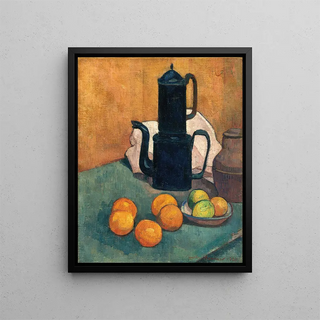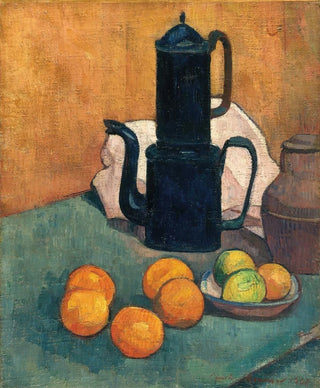Art print | The blue coffee pot - Émile Bernard


View from behind

Frame (optional)
In the vibrant world of post-impressionist art, "La cafetière bleue" by Émile Bernard stands out for its boldness and originality. This artwork, which transcends the simple motif of an everyday object, invites the viewer to immerse themselves in a world where color and form blend harmoniously. The coffee pot, emblematic of domestic life, becomes here the symbol of an aesthetic quest, an exploration of nuances and shadows. Through this piece, Bernard transports us to a universe where the mundane becomes sublime, where each brushstroke reveals a profound intention.
Style and uniqueness of the work
"La cafetière bleue" is characterized by a distinctive style that combines geometric rigor with a palette of vibrant colors. The shades of blue, yellow, and red intertwine with surprising delicacy, creating an atmosphere that is both warm and contemplative. Bernard, a true master of color, manages to breathe new life into this ordinary object, transforming it into a work of art that intrigues and captivates. The simplified shapes and sharp contours reflect the influence of Japanese art, a movement that profoundly impacted artists of his era. The composition, both balanced and dynamic, invites the eye to wander into the details, to explore the subtleties of light and shadow dancing across the surface of the canvas.
The artist and his influence
Émile Bernard, an emblematic figure of the post-impressionist movement, established himself as an innovator of his time. Born in 1868, he was a key player in the transition between realism and abstraction. His friendship with artists such as Paul Gauguin and Vincent van Gogh deeply influenced his artistic practice. Bernard explored various themes, ranging from nature to daily life, while incorporating diverse influences, notably those of Eastern art. His work on color and form paved the way for new experiments, inspiring generations of artists. Through "La cafetière bleue," he reminds us that art can transcend everyday life, revealing the hidden beauty in the simplest objects.

Matte finish

View from behind

Frame (optional)
In the vibrant world of post-impressionist art, "La cafetière bleue" by Émile Bernard stands out for its boldness and originality. This artwork, which transcends the simple motif of an everyday object, invites the viewer to immerse themselves in a world where color and form blend harmoniously. The coffee pot, emblematic of domestic life, becomes here the symbol of an aesthetic quest, an exploration of nuances and shadows. Through this piece, Bernard transports us to a universe where the mundane becomes sublime, where each brushstroke reveals a profound intention.
Style and uniqueness of the work
"La cafetière bleue" is characterized by a distinctive style that combines geometric rigor with a palette of vibrant colors. The shades of blue, yellow, and red intertwine with surprising delicacy, creating an atmosphere that is both warm and contemplative. Bernard, a true master of color, manages to breathe new life into this ordinary object, transforming it into a work of art that intrigues and captivates. The simplified shapes and sharp contours reflect the influence of Japanese art, a movement that profoundly impacted artists of his era. The composition, both balanced and dynamic, invites the eye to wander into the details, to explore the subtleties of light and shadow dancing across the surface of the canvas.
The artist and his influence
Émile Bernard, an emblematic figure of the post-impressionist movement, established himself as an innovator of his time. Born in 1868, he was a key player in the transition between realism and abstraction. His friendship with artists such as Paul Gauguin and Vincent van Gogh deeply influenced his artistic practice. Bernard explored various themes, ranging from nature to daily life, while incorporating diverse influences, notably those of Eastern art. His work on color and form paved the way for new experiments, inspiring generations of artists. Through "La cafetière bleue," he reminds us that art can transcend everyday life, revealing the hidden beauty in the simplest objects.






